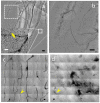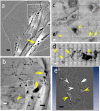Gold nanoparticles as high-resolution X-ray imaging contrast agents for the analysis of tumor-related micro-vasculature
- PMID: 22409971
- PMCID: PMC3316138
- DOI: 10.1186/1477-3155-10-10
Gold nanoparticles as high-resolution X-ray imaging contrast agents for the analysis of tumor-related micro-vasculature
Abstract
Background: Angiogenesis is widely investigated in conjunction with cancer development, in particular because of the possibility of early stage detection and of new therapeutic strategies. However, such studies are negatively affected by the limitations of imaging techniques in the detection of microscopic blood vessels (diameter 3-5 μm) grown under angiogenic stress. We report that synchrotron-based X-ray imaging techniques with very high spatial resolution can overcome this obstacle, provided that suitable contrast agents are used.
Results: We tested different contrast agents based on gold nanoparticles (AuNPs) for the detection of cancer-related angiogenesis by synchrotron microradiology, microtomography and high resolution X-ray microscopy. Among them only bare-AuNPs in conjunction with heparin injection provided sufficient contrast to allow in vivo detection of small capillary species (the smallest measured lumen diameters were 3-5 μm). The detected vessel density was 3-7 times higher than with other nanoparticles. We also found that bare-AuNPs with heparin allows detecting symptoms of local extravascular nanoparticle diffusion in tumor areas where capillary leakage appeared.
Conclusions: Although high-Z AuNPs are natural candidates as radiology contrast agents, their success is not guaranteed, in particular when targeting very small blood vessels in tumor-related angiography. We found that AuNPs injected with heparin produced the contrast level needed to reveal--for the first time by X-ray imaging--tumor microvessels with 3-5 μm diameter as well as extravascular diffusion due to basal membrane defenestration. These results open the interesting possibility of functional imaging of the tumor microvasculature, of its development and organization, as well as of the effects of anti-angiogenic drugs.
Figures







Similar articles
-
Gold nanoparticles as multimodality imaging agents for brain gliomas.J Nanobiotechnology. 2015 Nov 20;13:85. doi: 10.1186/s12951-015-0140-2. J Nanobiotechnology. 2015. PMID: 26589283 Free PMC article.
-
Synchrotron microangiography studies of angiogenesis in mice with microemulsions and gold nanoparticles.Anal Bioanal Chem. 2010 Jul;397(6):2109-16. doi: 10.1007/s00216-010-3775-8. Epub 2010 Jun 6. Anal Bioanal Chem. 2010. PMID: 20526770
-
Folic acid-cysteamine modified gold nanoparticle as a nanoprobe for targeted computed tomography imaging of cancer cells.Mater Sci Eng C Mater Biol Appl. 2018 Aug 1;89:182-193. doi: 10.1016/j.msec.2018.03.015. Epub 2018 Mar 27. Mater Sci Eng C Mater Biol Appl. 2018. PMID: 29752088
-
Gold nanoparticles as contrast agents in x-ray imaging and computed tomography.Nanomedicine (Lond). 2015 Jan;10(2):321-41. doi: 10.2217/nnm.14.171. Nanomedicine (Lond). 2015. PMID: 25600973 Review.
-
Polymer decorated gold nanoparticles in nanomedicine conjugates.Adv Colloid Interface Sci. 2017 Nov;249:386-399. doi: 10.1016/j.cis.2017.01.007. Epub 2017 Feb 15. Adv Colloid Interface Sci. 2017. PMID: 28259207 Review.
Cited by
-
Gold nanoparticles and angiogenesis: molecular mechanisms and biomedical applications.Int J Nanomedicine. 2019 Sep 19;14:7643-7663. doi: 10.2147/IJN.S223941. eCollection 2019. Int J Nanomedicine. 2019. PMID: 31571869 Free PMC article. Review.
-
The new X-ray/visible microscopy MAXWELL technique for fast three-dimensional nanoimaging with isotropic resolution.Sci Rep. 2022 Jun 11;12(1):9668. doi: 10.1038/s41598-022-13377-w. Sci Rep. 2022. PMID: 35690597 Free PMC article.
-
The potential of L-shell X-ray fluorescence CT (XFCT) for molecular imaging.Br J Radiol. 2015;88(1055):20140308. doi: 10.1259/bjr.20140308. Epub 2015 Jul 24. Br J Radiol. 2015. PMID: 26204972 Free PMC article. Review.
-
The "Fingerprint" of Cancer Extends Beyond Solid Tumor Boundaries: Assessment With a Novel Ultrasound Imaging Approach.IEEE Trans Biomed Eng. 2016 May;63(5):1082-6. doi: 10.1109/TBME.2015.2479590. Epub 2015 Sep 18. IEEE Trans Biomed Eng. 2016. PMID: 26394410 Free PMC article.
-
In Vivo Quantitative Microcomputed Tomographic Analysis of Vasculature and Organs in a Normal and Diseased Mouse Model.PLoS One. 2016 Feb 24;11(2):e0150085. doi: 10.1371/journal.pone.0150085. eCollection 2016. PLoS One. 2016. PMID: 26910759 Free PMC article.
References
-
- Meuli R, Hwu Y, Je JH, Margaritondo G. Synchrotron radiation in radiology--part II: radiology techniques based on synchrotron sources. Eur Radiol. 2004;14:1550–1560. - PubMed
Publication types
MeSH terms
Substances
LinkOut - more resources
Full Text Sources
Other Literature Sources

